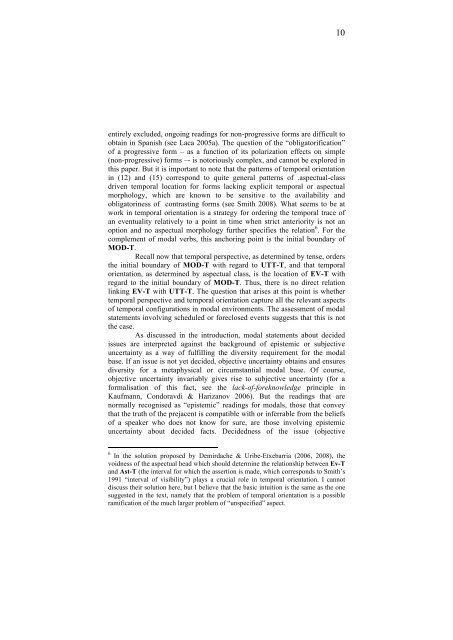On modal tenses and tensed modals - UMR 7023 - CNRS
On modal tenses and tensed modals - UMR 7023 - CNRS
On modal tenses and tensed modals - UMR 7023 - CNRS
You also want an ePaper? Increase the reach of your titles
YUMPU automatically turns print PDFs into web optimized ePapers that Google loves.
10<br />
entirely excluded, ongoing readings for non-progressive forms are difficult to<br />
obtain in Spanish (see Laca 2005a). The question of the “obligatorification”<br />
of a progressive form – as a function of its polarization effects on simple<br />
(non-progressive) forms –- is notoriously complex, <strong>and</strong> cannot be explored in<br />
this paper. But it is important to note that the patterns of temporal orientation<br />
in (12) <strong>and</strong> (15) correspond to quite general patterns of .aspectual-class<br />
driven temporal location for forms lacking explicit temporal or aspectual<br />
morphology, which are known to be sensitive to the availability <strong>and</strong><br />
obligatoriness of contrasting forms (see Smith 2008). What seems to be at<br />
work in temporal orientation is a strategy for ordering the temporal trace of<br />
an eventuality relatively to a point in time when strict anteriority is not an<br />
option <strong>and</strong> no aspectual morphology further specifies the relation 6 . For the<br />
complement of <strong>modal</strong> verbs, this anchoring point is the initial boundary of<br />
MOD-T.<br />
Recall now that temporal perspective, as determined by tense, orders<br />
the initial boundary of MOD-T with regard to UTT-T, <strong>and</strong> that temporal<br />
orientation, as determined by aspectual class, is the location of EV-T with<br />
regard to the initial boundary of MOD-T. Thus, there is no direct relation<br />
linking EV-T with UTT-T. The question that arises at this point is whether<br />
temporal perspective <strong>and</strong> temporal orientation capture all the relevant aspects<br />
of temporal configurations in <strong>modal</strong> environments. The assessment of <strong>modal</strong><br />
statements involving scheduled or foreclosed events suggests that this is not<br />
the case.<br />
As discussed in the introduction, <strong>modal</strong> statements about decided<br />
issues are interpreted against the background of epistemic or subjective<br />
uncertainty as a way of fulfilling the diversity requirement for the <strong>modal</strong><br />
base. If an issue is not yet decided, objective uncertainty obtains <strong>and</strong> ensures<br />
diversity for a metaphysical or circumstantial <strong>modal</strong> base. Of course,<br />
objective uncertainty invariably gives rise to subjective uncertainty (for a<br />
formalisation of this fact, see the lack-of-foreknowledge principle in<br />
Kaufmann, Condoravdi & Harizanov 2006). But the readings that are<br />
normally recognised as “epistemic” readings for <strong>modal</strong>s, those that convey<br />
that the truth of the prejacent is compatible with or inferrable from the beliefs<br />
of a speaker who does not know for sure, are those involving epistemic<br />
uncertainty about decided facts. Decidedness of the issue (objective<br />
6 In the solution proposed by Demirdache & Uribe-Etxebarria (2006, 2008), the<br />
voidness of the aspectual head which should determine the relationship between Ev-T<br />
<strong>and</strong> Ast-T (the interval for which the assertion is made, which corresponds to Smith’s<br />
1991 “interval of visibility”) plays a crucial role in temporal orientation. I cannot<br />
discuss their solution here, but I believe that the basic intuition is the same as the one<br />
suggested in the text, namely that the problem of temporal orientation is a possible<br />
ramification of the much larger problem of “unspecified” aspect.

















